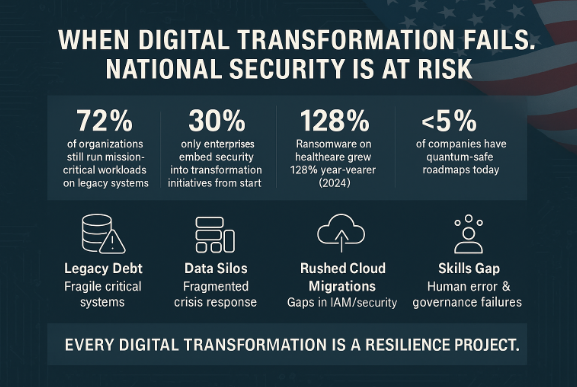Every few weeks, another headline screams about a hack, outage, or ransomware attack that grinds a business to a halt. Most recently, Jaguar Land Rover’s smart factories went offline after a cyberattack hit one of its IT service providers, disrupting production worldwide. JLR wasn’t hacked directly — its supply chain was. That single weak link cascaded into downtime for thousands of workers and delayed shipments across the globe.
This is the uncomfortable truth of digital transformation in 2025: When it fails, it’s no longer just a boardroom or IT problem. It’s a national security issue.
From Business Projects to National Resilience
For years, we’ve treated digital transformation as a “business initiative” — a way to modernize operations, cut costs, or improve customer experiences. But transformation has moved well beyond the boundaries of any single enterprise.
When an airline’s reservation system goes dark, it doesn’t just inconvenience a few passengers — it paralyzes national transportation networks. When a hospital’s systems are locked by ransomware, it doesn’t just hit a balance sheet — it puts lives at risk. When pipelines, ports, or logistics systems fail, the economy stutters.
Digital transformation is no longer optional modernization. It is now foundational to how nations run. Which means when it goes wrong, the consequences ripple far outside the walls of any one company.
Where Transformation Breaks Down
The failures aren’t hard to spot. In fact, they repeat with depressing predictability:
- Legacy debt: Too many mission-critical systems still sit on brittle, decades-old software and hardware. When modernization plans stall or underfund, these systems remain exposed.
- Data fragmentation: Organizations migrate parts of their infrastructure to the cloud without integrating or cleaning up data silos. In a crisis, real-time response becomes impossible.
- Security as an afterthought: Cloud migrations, automation rollouts, and AI pilots are often rushed forward without proper identity, access, and monitoring controls.
- Talent and culture gaps: Digital transformation is as much about people as technology. Yet leadership frequently underestimates the skills, training, and governance shifts needed.
Put all this together, and you have a fragile house of cards. And adversaries are watching.
When Business Weakness Becomes a National Threat
We like to imagine cyberwarfare targeting military assets, but adversaries aren’t always going after jets and submarines. The softer, more disruptive targets are civilian systems that nations rely on every day.
Think about it:
- Pipelines and energy grids — as Colonial Pipeline showed in 2021, one ransomware incident can cause regional fuel shortages.
- Transportation and logistics — an airline or port system outage halts economic flow and can paralyze supply chains.
- Healthcare systems — ransomware has forced hospitals to cancel surgeries and divert patients, with tragic results.
- Banking and finance — downtime in payment systems isn’t just an inconvenience; it’s a systemic risk.
Now add in the specter of “harvest now, decrypt later.” Data stolen today could be decrypted tomorrow as quantum computing advances. That means sensitive information from under-secured systems today is already a ticking time bomb.
Leadership Responsibility: CXOs as Stewards of National Resilience
For CXOs, this isn’t about running IT projects. It’s about leading national resilience efforts. That’s not hyperbole — it’s reality.
Here’s what leadership must prioritize:
- Security by design: Cybersecurity isn’t a checkbox at the end. It has to be built into every digital initiative from the start.
- Resilience over speed: The old “move fast and break things” mentality is dangerous. In critical infrastructure, what breaks is society.
- Crypto-agility: Begin planning now for quantum-safe cryptography and agile approaches to encryption.
- Board-level accountability: Digital risk must be treated with the same gravity as financial or regulatory risk.
- Public-private collaboration: Private enterprises run the systems governments rely on. Working together isn’t optional — it’s survival.
The Cost of Getting it Wrong
When Jaguar Land Rover’s factories went silent, it was a corporate crisis. But imagine if it had been a defense contractor or a major energy supplier. Suddenly, the implications escalate from shareholder value to national security readiness.
Digital transformation that stalls, fails, or shortcuts isn’t just about disappointing customers or missing quarterly targets. It becomes an open door for adversaries to walk through, a lever to disrupt economies and societies.
Shimmy’s Take
We’ve long accepted that digital transformation is “strategic.” What we’ve been slower to accept is that failed digital transformation is existential. The fragile patchwork of legacy systems, rushed cloud migrations, and overlooked security controls isn’t just a business liability — it’s a national security vulnerability.
The mantra of Silicon Valley — “move fast and break things” — might have built some cool apps. But when what breaks is a hospital system, an airline network, or an energy grid, it isn’t innovation. It’s negligence.
Digital leaders need to reframe their mission: Every transformation project is a resilience project. Every system modernized, every silo integrated, every risk mitigated, strengthens not just your enterprise but your nation’s digital backbone.
If we don’t start treating it that way, we’re building a digital Maginot Line — impressive on the outside, but destined to collapse when tested.

